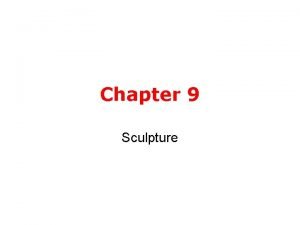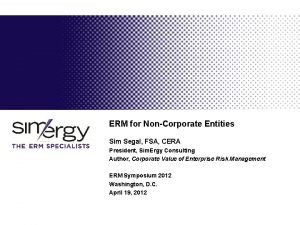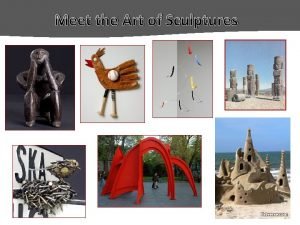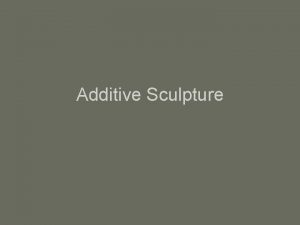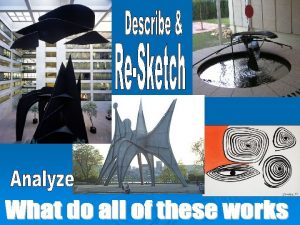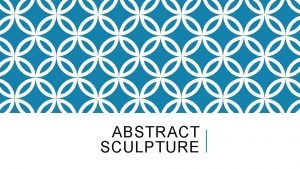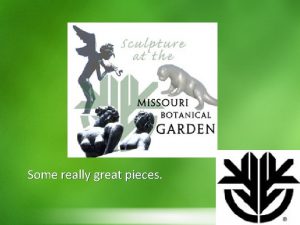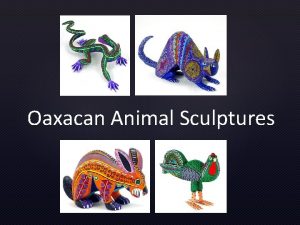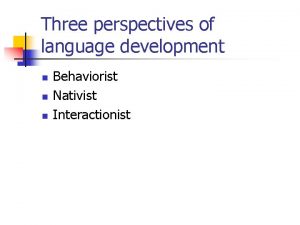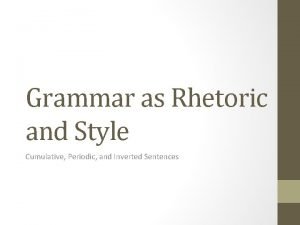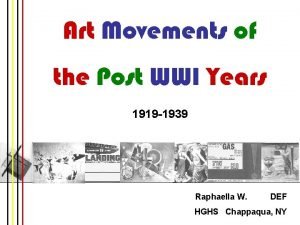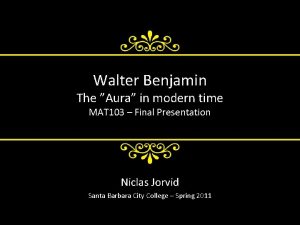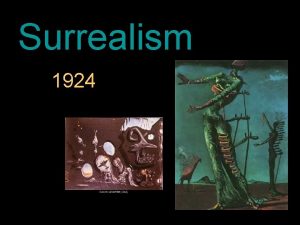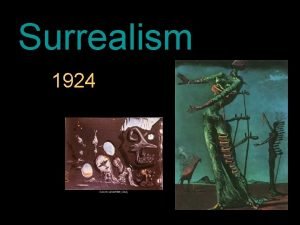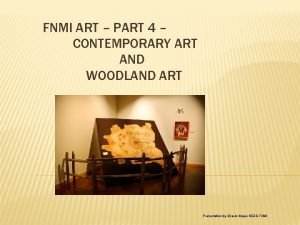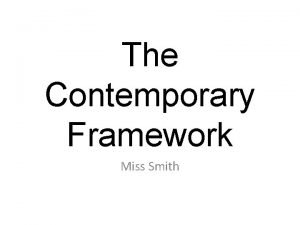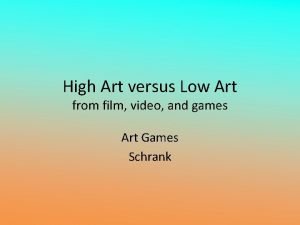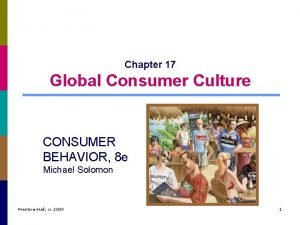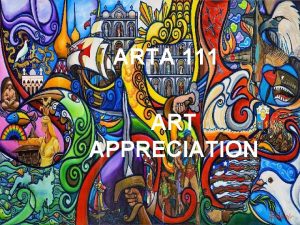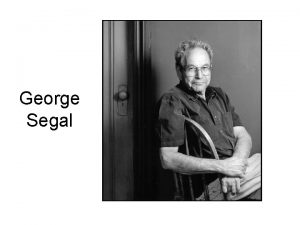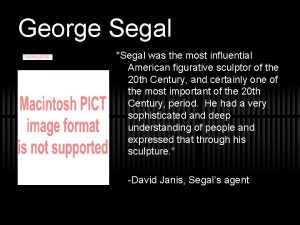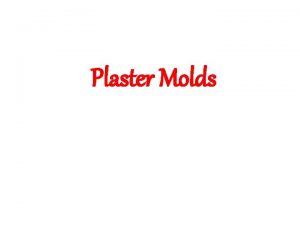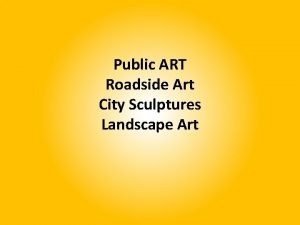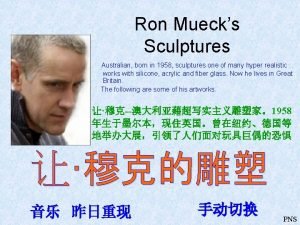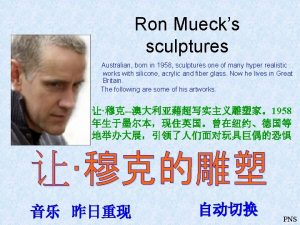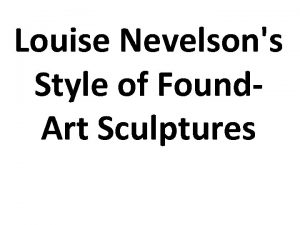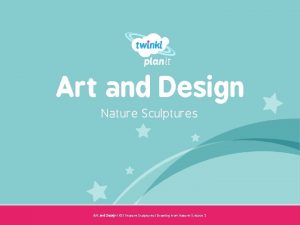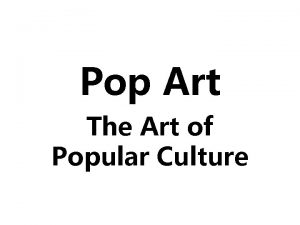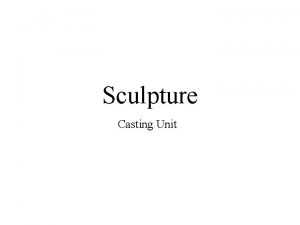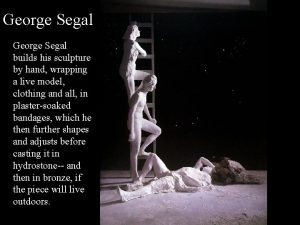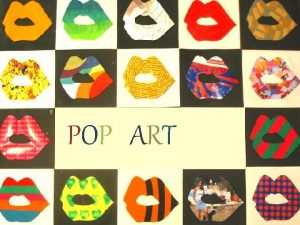George Segal Sculptures Style of art that emerged
















































- Slides: 48



















George Segal Sculptures








• Style of art that emerged in Britain and the US in the 50’s • Examines the distinction between “high art” and popular culture and questions the role of the artist • Term to refer to “popular” or mass culture • Images so commonplace we hardly notice them even though we absorb them totally • Reaction against Abstract Expressionism – Art no longer needs to be something emotional

• Many different styles • Artists are interested in the images of mass media, advertising, comics and consumer products • Shake viewers out of their accustomed ways of looking at the most trivial trappings of modern life

Claes Oldenburg Enlarged ordinary household objects

American Sculptor • Started off by making sculptures of things he saw around him out of found materials • Developed the technique of soft sculpture, which added a surrealist effect to his sculpture • Illustrated how Pop Art added surprise, curiosity and humor into the art of the 2 nd half of the 20 th century

• Oldenburg saw himself as a realist, not as an abstract artist. He felt art must relate to the realities of everyday life. • Yet he took objects from the real world and placed them out of context, making them soft when they should be hard, large when they should be small. – Which in turn made them somewhat abstract. • This paradox in his art grew out of his own nature, which was a complex mix of traditional and radical elements.

• 1965 – begins his “monument” proposals – A single object was to be enlarged to gigantic scale and installed at a specific site • By taking mundane objects and presenting them out of context and in such colossal proportions, Oldenburg forced viewers to reassess their daily lives and values. • His work was a social commentary on American popular culture and, by association, on contemporary society's approach to life itself.

• Wanted viewers to stop and think about the products of the industrial and commercial culture • Wants to call attention that we have come to rely on these products


George Segal Study of form, emotion and the surroundings

American Painter and Sculptor • Painter – 1950’s started figurative painting – Early work considered pop art • Sculptor – Examined relationship of fine art to popular art forms – Reference to individual place in mass culture

Philosophy • Life-size plaster human sculptures – Human figures in space and related surroundings – Influenced by artist Edward Hopper – Attention to attitude and gestures – Rural and urban settings Nighthawks (1942) close up

Edward Hopper Examples Cape Cod Morning Room in Brooklyn

Edward Hopper Examples Cont. Room in New York Summer Evening

Edward Hopper Examples Cont. Summer in the City Sunday

Medium • Cast plaster molds of living figures • Attempt to lock to them in time in constructed environment

Process • • Select situation Select a person and pose Cast figure, sometimes in clothing Soaked bandages in plaster and applied and shaped them to the body

First works • Man Sitting at a Table (1961) • Used only outside unpainted surface of cast • Abstract, impressionistic, disembodied anonymous quality//depersonalized social settings

First works examples Man sitting at a table (1961) Notice! • simple almost sterile environment • anonymous//depersonalize d nature • abstract and impressionistic • What is the emotional quality? • What do you think about when you view this?

Later works • Parking Garage (1968): Poured industrial plaster inside cast to capture details of expression and physical form: more lifelike • The Corridor (1976): cast and painted in vivid colors as metaphors for “rosy disposition” “blue funk” and “a black mood”

Later works examples Parking Garage (1968) The Corridor (1976)

New Approaches • Fragments and groups of figures in social settings • Sound and lighting effects • Cast still-life scenes from works by major modern artists: Picasso’s Chair (1973)

New approaches examples George Segal Picasso’s Chair (1973) Pablo Picasso The Chair Similarities? Differences? ?
 Three figures and four benches
Three figures and four benches Eran segal
Eran segal Eran segal
Eran segal Sim segal
Sim segal Morro vermelho 1926
Morro vermelho 1926 Yaniv segal
Yaniv segal Recortes de ciencias sociales
Recortes de ciencias sociales Sculptures
Sculptures Additive sculpture
Additive sculpture Louise nevelson sky cathedral
Louise nevelson sky cathedral What did claus oldenburg create sculptures of?
What did claus oldenburg create sculptures of? Linear sculpture definition
Linear sculpture definition Subtractive sculpture examples
Subtractive sculpture examples Sculptures of musicians
Sculptures of musicians Oaxacan animal sculptures
Oaxacan animal sculptures Relief sculpture types
Relief sculpture types An artist who makes sculptures
An artist who makes sculptures Phân độ lown
Phân độ lown Premature atrial contraction
Premature atrial contraction Thể thơ truyền thống
Thể thơ truyền thống Thơ thất ngôn tứ tuyệt đường luật
Thơ thất ngôn tứ tuyệt đường luật Walmart thất bại ở nhật
Walmart thất bại ở nhật Tìm độ lớn thật của tam giác abc
Tìm độ lớn thật của tam giác abc Con hãy đưa tay khi thấy người vấp ngã
Con hãy đưa tay khi thấy người vấp ngã Tôn thất thuyết là ai
Tôn thất thuyết là ai Gây tê cơ vuông thắt lưng
Gây tê cơ vuông thắt lưng Sau thất bại ở hồ điển triệt
Sau thất bại ở hồ điển triệt What was urdu hindi controversy
What was urdu hindi controversy Democratic developments in england
Democratic developments in england Who emerged as patrons in the baroque period?
Who emerged as patrons in the baroque period? Differences between george washington and king george iii
Differences between george washington and king george iii George washington vs king george iii venn diagram
George washington vs king george iii venn diagram Parts of modified block style letter
Parts of modified block style letter Writing style examples
Writing style examples Informal style of writing
Informal style of writing Nnn speech
Nnn speech Plain style vs high style
Plain style vs high style Periodic vs cumulative sentence
Periodic vs cumulative sentence What type of art
What type of art Dada art movement characteristics
Dada art movement characteristics What art style is this an example of
What art style is this an example of Salvador dali art movement
Salvador dali art movement Salvador dali art movement
Salvador dali art movement Woodland style art
Woodland style art Contemporary framework meaning
Contemporary framework meaning Drama in art appreciation
Drama in art appreciation Low art examples
Low art examples What is high art and low art
What is high art and low art Art and artisans production process
Art and artisans production process
